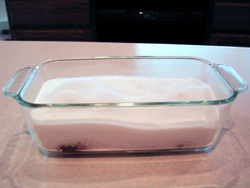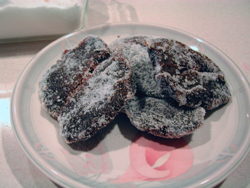[an error occurred while processing this directive]
Salting has always been one of the most common methods for preserving meats, so after coming across reference after reference to salted meats in medieval cookbooks, I decided to try it out.
The theory is simple – a sufficiently high amount of salt will dehydrate the meat and prevent any bacteria or mold from growing. However, to the modern mind which is accustomed to refrigeration, the practice of leaving raw meat out on the counter for a couple of weeks seems more than a bit creepy.
Each time I’ve done this, the end result has been safe to eat (or at least apparently so – it tasted good and I stayed healthy). For anyone following these directions though, you do so at your own risk. If the end result smells nasty, you eat it anyways, and you get sick and die, then don’t come complaining to me.
For this experiment, I took approximately one pound of raw venison cut into half inch thick steaks. It had been previously frozen, but was thawed completely, rinsed, and patted dry with a paper towel.
 raw venison
raw venison
I put a thick layer of salt into the bottom of a glass baking dish, put the venison on top, and covered it with more salt. I then repeated this with a second layer. I then covered the whole thing with plastic wrap and left the dish out on the counter for 24 hours.
 venison packed in salt
venison packed in salt
 the same dish a day later
the same dish a day later
The next day the salt had developed a disturbing pink color and there was a layer of thick red liquid at the bottom. I pulled the steaks out and brushed the salt off them, dumped the pink salt and nasty red liquid down the drain, and re-packed the steaks with fresh salt.
 steaks after one day in salt
steaks after one day in salt
I was prepared to repeat this process the next day, but the salt didn’t discolor at all and no further red liquid formed.
 fourteen days later
fourteen days later
After two weeks I decided it was time to check the results. The salt had solidified into a crust, and the venison had turned dark and was very hard.
 salted venison steaks
salted venison steaks
I cut one of the steaks in half to check the inside, and while it was a lighter color than the outside, it was still just as hard and dry. At this point the meat smelled substantially better than it did when raw. It’s worth noting though that throughout the whole process it never smelled unpleasant.
 steak cut in half
steak cut in half
 the inside is lighter in color
the inside is lighter in color
The proof of course is in the eating. I rinsed the steaks in water and then boiled them in a mixture of water and cheap red wine. After an hour of this, I dumped the liquid out and did it again. The liquid tasted quite salty after the second boiling, so I replaced it once more and boiled it for another 20 minutes.
I then cut the meat into thin slices and served it with mustard. The venison was slightly salty and had developed a bit of a smoky flavor. The whole process was somewhat tedious, but very easy. I’ll have to see how well it works for camp cooking.
Source [Le Ménagier de Paris, J. Hinson (trans.)]: Venison of Deer or Other Beast, If you wish to salt it in summer, it is appropriate to salt it in a wash-tub or bath, ground coarse salt, and after dry it in the sun. Haunch, that is the rump, which is salted, should be cooked first in water and wine for the first boiling to draw out the salt: and then throw out the water and wine, and after put to partly cook in a bouillon of meat and turnips, and serve in slices with some of the liquid in a dish and venison.
[an error occurred while processing this directive]











































